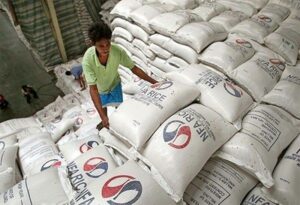By Adrian H. Halili, Reporter
THE National Food Authority’s (NFA) inability to meet its rice procurement targets has raised questions about the agency’s capacity to stabilize rice prices, an economist said.
“The government needs to find alternative ways of insulating our country from the vagaries of trade and, in the process, reducing the need for price supports and buffer stocks,” Ateneo de Manila economics professor Leonardo A. Lanzona said in a Facebook Messenger chat.
He was referring to current plans to amend the Rice Tariffication Law of 2019 to restore the NFA’s power to regulate rice prices,
Mr. Lanzona added that other forms of market intervention “because NFA has been notorious for missing its procurement targets.”
In its quarterly procurement report, the NFA said it purchased 4.353 metric tons (MT) or 87,067 bags of palay or unmilled rice. The targets for the quarter were 67,145 MT or 1.34 million bags of palay.
It said that the low procurement during the period was due to “active participation” of traders offering higher farmgate prices compared to the government buying price.
The Rice Tariffication Law (Republic Act No. 11203) privatized the function of importing rice formerly carried out by the NFA. Instead, private traders were allowed to bring in their own shipments but had to pay a tariff of 35% on Southeast Asian grain.
The NFA had been reduced to maintaining an emergency inventory of domestically grown rice.
“We need to make sure that any market intervention by the NFA is not too costly, is not tainted again with corruption, and does not backfire on farmers,” Raul Q. Montemayor, national manager of the Federation of Free Farmers, said in a Viber message.
Mr. Montemayor added that the power to decide on where to buy, how much, and when to dispose of rice should be decided by the Secretary of Agriculture, and NFA officials, with NFA involvement limited to “providing logistical support to the DA.”
In a senate hearing, the DA proposed the return to the NFA of its power to intervene in the rice market. Agriculture Secretary Francisco P. Tiu Laurel, Jr. said such interventions would help correct price distortions.
On the other hand, Bantay Bigas Spokesperson Cathy L. Estavillo said that the restoration of NFA powers should come with increased funding to purchase domestically grown rice.
In a statement on Thursday, the NFA said that it would need P16.3 billion next year to procure the target volume for the national rice reserve and additional funding to upgrade its storage capacity.
“Currently, NFA only has the capacity to dry 31,000 metric tons but buys around 495,000 metric tons of palay. NFA is required by law to maintain a buffer stock equivalent to about nine days of national rice consumption,” it said.
The House of Representatives approved the amendments to the Rice Tariffication Law on second reading on Tuesday.
Amendments include authorization for the NFA to sell rice during emergencies and increased funding for the Rice Competitiveness Enhancement Fund to P15 billion, while extending the life of the fund by six years.
